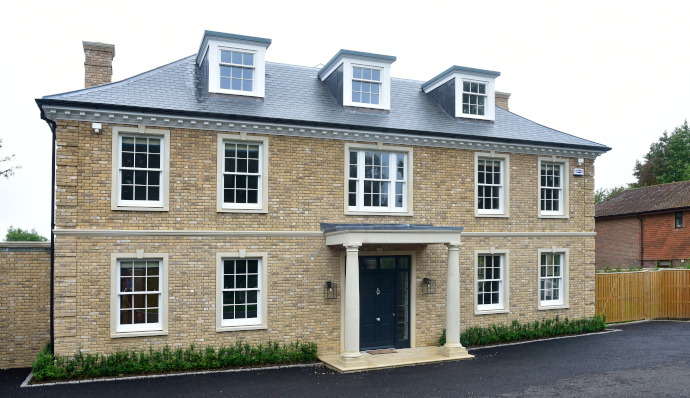Chelsea Trends: Caring For Wildlife
Tuesday, May 23 , 2023
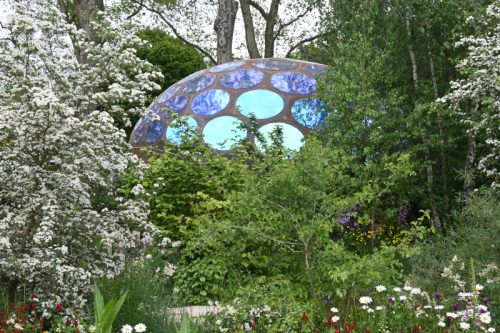
This week at the Chelsea Flower Show there has been a theme of wildlife and conservation. The stories told by the gardens show that the wildlife from the insects in your garden to gorillas in Africa all need protecting so the world can flourish for everyone. This is why the weeds are kept and even encouraged in many show gardens as wildflowers. Let’s take a look.
The Fauna and Flora Garden
Designed by Jilayne Rickards
The garden is a miniature ecotourist gorilla trek. The rough track through lush foliage journeys up to a waterfall that cascades down a rockface, disappearing into the planting. This garden depicts the changing landscapes in the protected forest area to secure the habitat to expand the numbers of gorillas to save these endangered great apes.
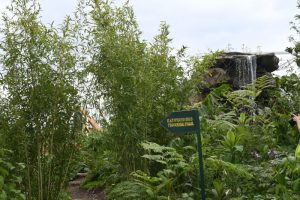
The garden represents a path for an eco trek to observe gorillas in their natural habitat.
The planting includes the flora eaten typically by gorillas, including banana plants with a true-to-life nest long the way, nestled amongst the bamboo. At the bottom of the garden there’s a typical tourist kiosk selling local crafts. This is to show how conserving the forests for eco tourism allows the local people to make a better living saving the forest and the gorilla within it than they did from destroying it.

The waterfall looms above the show with a soothing sound of rushing water.
The garden aims to demonstrate the critical importance of protecting nature and how this can be best achieved by putting people and collaboration at the heart of conservation efforts. After the show it will be relocated to the world-famous Biomes of The Eden Project in Cornwall. The Eden Project supplied a number of plants for this striking Chelsea garden.
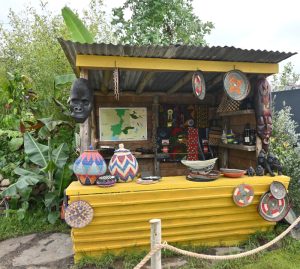
The garden educates how locals can make a living by saving the indigenous fauna and flora rather than destroying it for profit.
The Royal Entomological Society Garden
Designer Tom Massey
This garden has a huge domed outdoor laboratory, built into a hillside. It catches the light in mesmerizing colours and offers an ‘insect’s eye view’ for the landscape. The dome set with a myriad of circles, inspired by a compound insect eye and the lab is used for real scientific research, monitoring and studying insects visiting the garden.
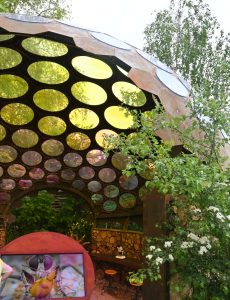
The beautiful dome inspired by an insect’s eye.
The planting attracts pollinators, providing sustenance all year round. The topography across the site provides varied habitats for insects with rammed earth floors, hoggin pathways, dead wood, piles of rubble, bare sand and gabion walls. with water in still pools and flowing streams, which also adds to the soundscape of the garden.
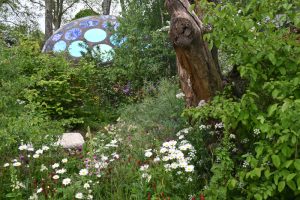
The garden is planted to provide a habitat for pollinators.
A dead tree ‘sculpture’, cut into rings and elevated on steel poles, ‘floats’ over biodiverse planting and a standing dead tree and tree stump provides further sculptural habitat. This garden is a move away from the traditional lawned garden, encouraging visitors to rewild parts of their gardens to create habitats for native wildlife.

The fallen tree sculpture shows the cycle of plants and their importance in the habitat.
After the show, the garden will be relocated to a permanent location at IQL Stratford in East London as a long-term opportunity for learning and insect research.
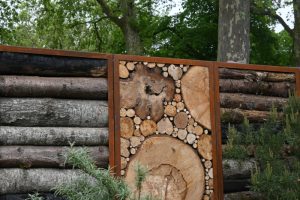
The garden is designed to encourage insect life.
RSPCA Garden
Designed by Martyn Wilson
This garden celebrates the two hundredth anniversary of the RSPCA. The planting has woodland vibes, with a naturalistic aesthetic and hints of RSPCA blue in the flowers. The whole garden is pollinator-friendly with a living plant roof on the shelter. The garden uses repurposed litter that would animals the birds the charity rescues and aims to protect.
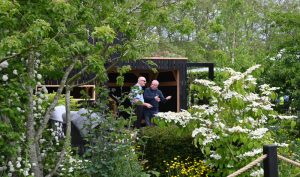
This garden is designed to encourage pollinators, which in turn improve bird health and breeding.
This restful garden is a space to sit and appreciate nature and wildlife, whilst reducing the damage people do to the environment reusing and repurposing plastics and litter.
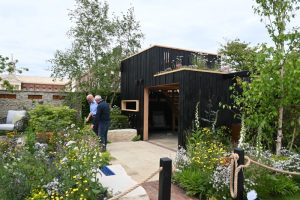
The garden has a mixture of trees and wildflowers with buttercups and foxgloves to help increase the diversity of insects and UK wildlife. The garden has a rural, naturalistic planting scheme with indigenous plants with a tranquil water feature for birds to enjoy.

Wildflowers
It’s not just the Show Gardens. The stands have living roofs too this year with masses of flowers for pollinators. Beautiful swathes of flowers entice bees and butterflies to increase the insect diversity to benefit all gardens and the world.
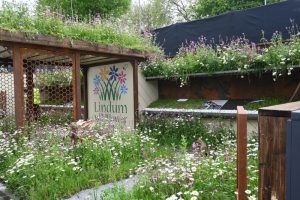
Check back tomorrow for more Chelsea news or pop into our show gardens in Kent for more garden inspiration.

Designed by Brand Skillings Ltd | Website managed by Weekend

